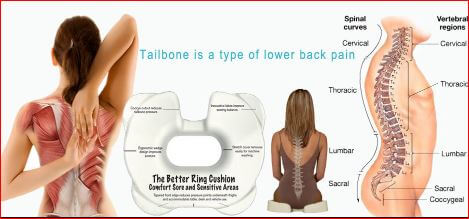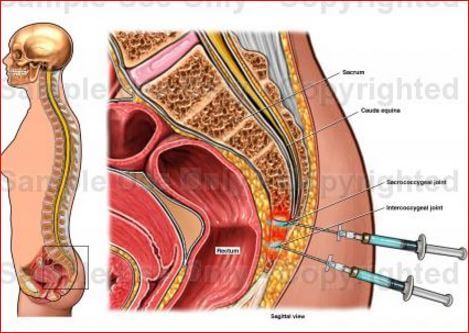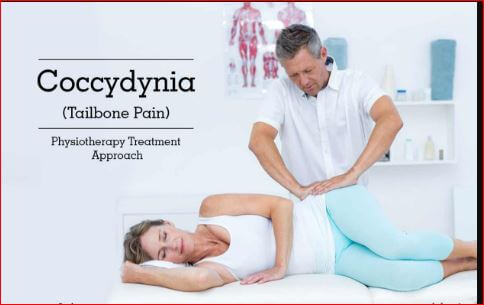What is Coccydynia?
Coccydynia a pain syndrome arises at the lower region of the spine i.e. in the coccyx region. In coccyx region 4-5 bones are fused and allows limited extent of locomotion. If unwanted movement occurs, then it can produce localized pain in this region.
Various alternative names such as tailbone pain, coccyx pain, coccygeal pain; all are denoted same coccydynia.

Symptoms
The pain symptoms varies from individual to individual depending upon the severity of the cause. Some individual is suffered from all the bellow mentioned symptoms, whereas some may not.
- Pain in the lower back region
- May sufferer cannot sit continuously for a few minutes
- Prolonged sitting raises pain symptom
- Pressure and even sometimes touching of the particular area can cause pain
- The postural changes like sitting position to standing position can worse the pain syndrome
- Bowel movement is painful, specifically for constipation and af ter defecation pain syndrome become relaxed
- Painful menstrual cycle in women
- Pain raises during intercourse
- Daily activities like driving, bending or works which need to prolonged sitting or postural changes.
- Sitting on a hard surface is difficult, but it may more severe, even in the soft surface. Because sitting on soft surface provide direct pressure in the coccyx, whereas sitting on hard surface provide the pressure on the pelvis. (2,3)
Causes
The cause of coccydynia occurs due to damaging of the tissue in the surrounding area of the coccyx and pain arises. The following are possible reasons, which cause coccydynia.
1.Childbirth
In the spine, muscles and ligaments hold the right positioning of the vertebral bone. Normally during third trimester of the pregnancy, coccyx become more flexible due to hormonal changes for smooth delivery.
The attached muscles and ligaments may become damaged during childbirth for the excessive pressure provided by the head of the child. This injury persists for a prolonged time and muscles and ligaments are unable to maintain the right positioning of the coccyx and cause coccydynia.
2.Coccygeal Injury
Any hard direct contact in the coccyx can cause coccygeal injury. The forceful contact during kicking or blowing can hurt the coccyx. Some contact sports or activities such as ice skating, skiing, falling down during horse riding or high jump or any other accidental trauma which hit directly the coccyx can cause coccydynia.
3.Repetitive strenuous injury
Any continuous activity such as prolonged travelling on bad road, bicycling, stretching of the pelvic region for performing gymnastic can damage the attached ligaments and muscles of the coccyx. This also causes coccydynia.
4.Wrong posture
Wrong sitting posture for prolonged time during office work, driving can cause damage of the muscles present in the coccyx.
5.Obesity
Obesity can cause excessive pressure on the coccyx and damage the muscles, which cause pain in the coccyx.
6.Lean Body
Lean body or underweight has less fat in the buttock and can cause easy damage of the ligaments can cause pain in the coccyx.
7.Increase age
With increasing age and daily wear and tear looses the cartilage or ligaments which hold the vertebral discs. This causes displacement of the coccyx, even due tight fitting of fused bones present in the coccyx can raise internal pressure and increase the pain.
8.Malignancy
Malignancy is rare cause which affects coccyx. Sarcoma or colon cancer can provide coccydynia as a symptom.

Diagnosis
The symptomatic discussion and medical history help to identify the cause of the coccydynia.
The physical examination is an important criteria for diagnosing the coccydynia. Any tenderness or swelling may develop due to disc degenerative disease.
For diagnosis, X-ray and MRI can be conducted. X-ray helps to determine the fracture of the coccyx bone. MRI helps to detect the infection or spinal tumor. (4)
Treatment
- Non-steroidal anti-inflammatory drugs like ibuprofen acetaminophene inhibit COX-2 which helps to reduce the inflammation and associated pain.
- If prescribed NSAIDs are unable to manage the pain, then steroidal drugs are prescribed for short duration to control pain.
- Ice- pack or cold compression helps to reduce the pain
- Hot compression or application alternative cold -heat can also effective treatment for reduction of pain.
- Donut-shaped cushion can prevent excess pressure during sitting or provide comfort in the coccyx.
- Laxative is prescribed to soften the stool for patient suffers from constipation,
- Physiotherapy, chiropractic and osteopathy are different spinal manipulation techniques, which can provide pain relieve for short- period. (2,3)

Exercises/Stretches
1.Pelvic floor exercise
This exercise is the technique to control the urination by contracting the pelvic floor muscle. This is a very beneficial for pregnant women to ease childbirth and also relief coccyx pain.
2.Abdominal muscle contraction
Lie down straight. Bend your knees and keep your palm at the back of your head. Then head move forward. Then squeeze the abdominal muscle and contract it and hold the position for a few seconds and then relax the muscles.
3.Walking or running on Treadmill
Regular walking or running on a treadmill can help to reduce the pain.
4.Anal lock
This exercise can be performed in sitting or lie down position. Then contract the anal sphincter and hold the position for a few seconds and then relax. (5)
References
- Coccydynia (Tailbone Pain) Video; http://www.spine-health.com/video/coccydynia-tail-bone-pain-video
- Coccydynia; NHS choices; http://www.nhs.uk/Conditions/coccydinia/Pages/Introduction.aspx
- Richard A. Staehler (2010); Coccydynia (Tailbone Pain) http://www.spine health.com/conditions/lower-back-pain/coccydynia-tailbone-pain
- Coccydynia – Causes; NHS choices; http://www.nhs.uk/Conditions/coccydinia/Pages/Causes.aspx
- Coccydynia Exercises for relieving Coccyx Pain or Tailbone Pain; http://coccyxcushionreview.com/coccydynia-exercises-coccyx/
